Explore The Timeless Mysteries At Preah Vihar Temple In 2026
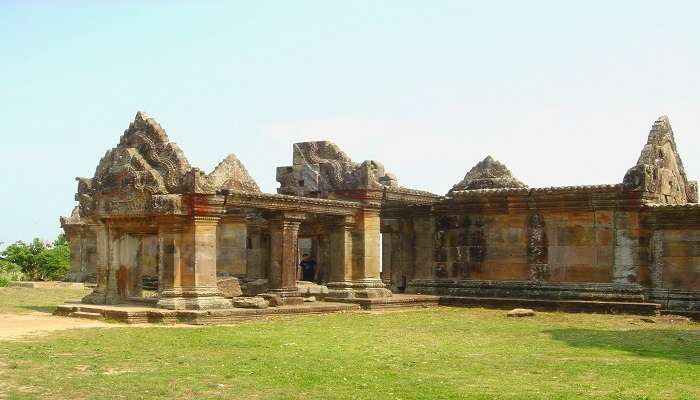
Preah Vihear, meaning “sacred sanctuary” in Sanskrit, is a famous temple in Cambodia with a presiding deity, Lord Shiva. The village it is situated is also named Preah Vihear Temple, a beautiful remote village with mostly Buddhist residents. The temple is visited by thousands of people from across the world, and it is famous for its striking architecture. It is quite an ancient temple with stone carvings and inscriptions that cover the various parts of the temple and mainly dominate the architecture. Besides its religious significance, the temple is also well-known for depicting the historical relationships and religious and architectural similarities with other temples in this region. To discover this beautiful architectural masterpiece, you must visit here once you’re in Cambodia.
Preah Vihear Temple History
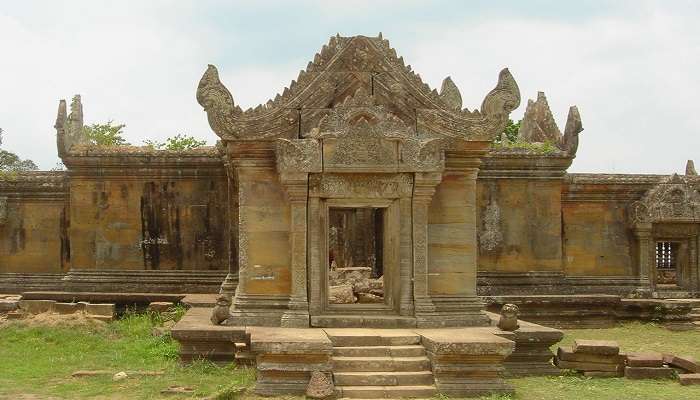
The history of the Preah Vihear Temple in Cambodia dates back to the 9th century AD, although the temple was remodelled again in the 11th century. The temple was constructed by the king of the Khmer Empire, initially by King Suryavarman 1 during his reign (1002-50) and later developed by Suryavarman II (1113-50). This temple has several attractive aspects, including the old stone buildings, a sequence of sanctuaries named “gopuras’ ‘ and its location, which is on top of the Dangrek mountains. The temple is dedicated to the Hindu deity Shiva for his incarnation as Bhadresvara and Sikharesvara, the mountain deities. The oldest surviving elements of this temple date back to the period of Koh Ker in the early part of the 10th century. At this time, the capital of the empire was also named after the city. Presently, the components of the
Must Read: Festivals In Cambodia
Preah Vihear Temple Architecture
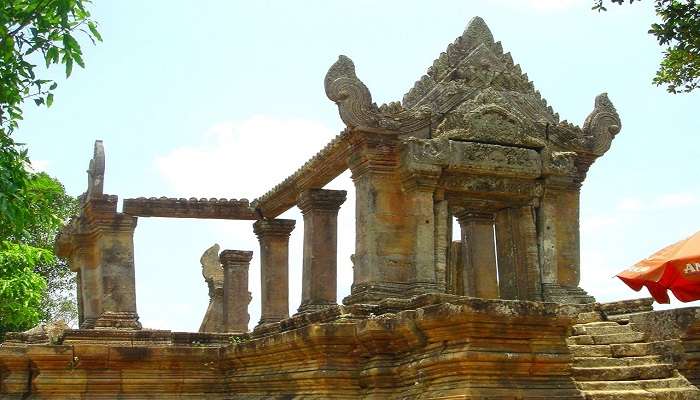
The Preah Vihear Temple architecture is very indifferent and unique. Built in the ancient style of Cambodian architecture, the temple has long stairways and a large alley leading to the first Gopura. This alley has pillars throughout and marks the initial level of the three mountain levels. There are Naga handrails amidst the top, third and fourth levels. Here, the corridors and galleries are meant for the rituals and religious events conducted within the temple surrounding the pivotal sanctum where the Linga is present. Small-sized bricks were also used to replace the huge rock slabs used to construct the corbel arches.
It was easier to use bricks for constructing corbelled roofs because they could be bound easily with mortar and were considered to be more feasible than solid rock slabs. The main tower has been constructed using huge sandstone blocks weighing almost five tons each. Many of these rocks have holes all over them for lifting them. While the visitors pass through the main entrance, they face a narrow stairway comprising 163 steps built out of huge stone slabs, out of which many are first cut out of the rock. The width of the stairway is 8 metres, and the length is 78.5 metres.
Suggested Read: Phnom Penh Nightlife
Places To Visit Near Preah Vihear Temple
There are multiple places near the Preah Vihear Temple that you can visit for a day outing. Let’s check out some of these places:
1. Neak Buos Temple
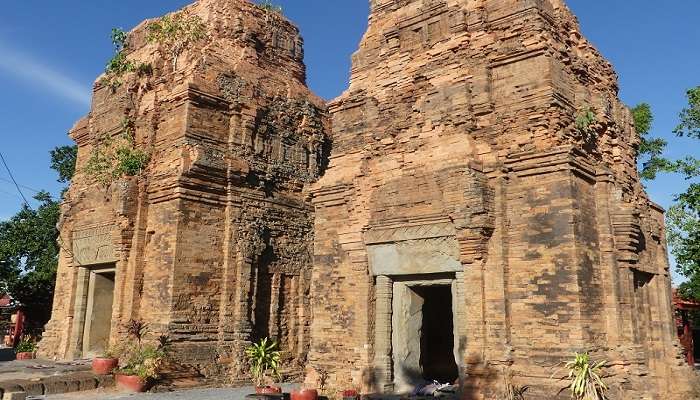
Located amidst the forest of Preah Vihear Province, it is named “The Tiger Cave Temple.” The ancient temple is an architectural marvel that dates back to the 7th century, with constant evolution occurring for a considerable period. The temple has a square structure and was built using brick, sandstone, and laterite. It was constructed on plain land as a spot to worship Brahmanism.
Distance from Preah Vihear Temple: 73.4 Km
Timings: 6 AM TO 5 PM
Suggested Read: Cambodian Street Food
2. Krapum Chhouk Temple

Krapum Chhouk Temple, located in the Romdos region in Rovieng district, is another major tourist attraction near the Preah Vihear temple. It is an ancient temple built in the 10th century with laterite and sandstone. The temple’s structure is unique, and several art pieces are carved on the walls in different parts.
Distance from Preah Vihear Temple: 150.6 Km
Timings: 5 AM to 6 PM
3. Koh Ker Temple

Awarded UNESCO status, Koh Ker Temple is one of the most historical places in the world and a favourite spot for historical buffs and archaeologists. It is constructed on the highland of Chhork Koki at a height of 35 metres and is dedicated to Trey Puvaneswaran, the god of happiness and prosperity.
Distance from Preah Vihear Temple: 136.7 Km
Timings: 5 AM to 6 PM
Suggested Read: Phimeanakas Temple
Preah Vihear Temple Location
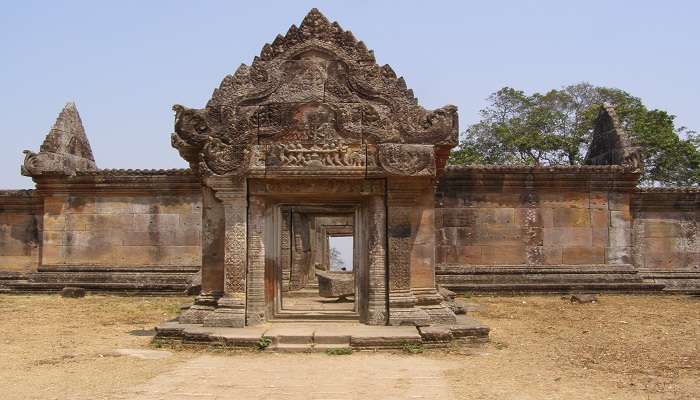
The temple was constructed on the top of the Poy Tadi, a crag in the Dangrek Mountain ranges, marking the border between Thailand and Cambodia. The place has been mentioned by Cambodia as a part of the Svay Chrum village in the Choam Khsant district of the Preah Vihear state, which is at a distance of 140 km from the famous Angkor Wat temple. Thailand also talked about the temple as a part of the Bhumsrol village in the Bueng Malu subdistrict in the Sisaket region, which is 110 km away from Mueang Sisaket District in the middle of the Sisaket province. Later, it was decided that the temple was a part of Cambodia and was accessible only from Cambodia.
The entire temple complex is spread across 800 metres through the north-south axis, and it faces towards the plains to the north, from where it can be cut off across the global border. It also comprises an alley and several steps that rise on the hill facing the sanctuary, which is located atop the cliff at the south end of the complex. The structure of this temple is completely different from the rest of the temples at Angkor; it also fulfils the purpose of a well-designed picture of Mount Meru. There are five Gopuras that slowly become visible as you start to enter the sanctuary. Hence, the fifth Gopura is the first one the visitors reach.
Further Read: Bakong Temples
The Preah Vihear temple, dedicated to Lord Shiva, is one of the most archival temples in Cambodia. It attracts thousands of visitors from different parts of the world who come to witness the spectacular architecture of this temple, which is well coordinated with the surrounding environment. If you’re planning a trip to Cambodia, don’t forget to add this temple to your itinerary for the most unique spiritual experience atop the mountains!
For our editorial codes of conduct and copyright disclaimer, please click here.
Cover Image Credit: Phnom Penh Office for Wikimedia Commons
Frequently Asked Questions About the Preah Vihear Temple
Is it worth visiting the Preah Vihear Temple?
A visit to the Preah Vihear Temple is completely worth it. You get to walk through the ancient roads and reach all the temples in the complex one by one.
At what height is the Preah Vihear Temple located?
The Preah Vihear Temple is located at the height of 1,722 ft above sea level.
What makes the Preah Vihear temple so famous?
The unique architecture of the Preah Vihear temple is what makes it indifferent. It showcases a marvellous presentation of the Khmer style of architecture in aspects like the plan, beautification and relation with the surroundings.
What are the times to visit the Preah Vihear temple?
The Preah Vihear temple remains open for visitors from 8:00 AM to 4:00 PM.
What are the entry fees at the Preah Vihear temple?
The entry fee at the Preah Vihear temple is USD 1.5 for the local visitors and USD 5 for the international visitors.
People Also Read:
Choeung Ek Genocidal Center Koh Ker Temple Pre Rup Temple

Passionate Marketing Student with a flair for storytelling, eagerly embarking on a journey within the vibrant world of travel. Excited to merge analytical acumen with creative skills to elevate the editorial landscape of the travel industry.











